Are you a Quiet Speculation member?
If not, now is a perfect time to join up! Our powerful tools, breaking-news analysis, and exclusive Discord channel will make sure you stay up to date and ahead of the curve.
Modern Top 5: Utility Spells kicked this series off, and in my eyes, it was hugely successful. Not only did it present a measurable way to analyze cards that I'm quite proud of, but the article also inspired a lively debate in the comments. Today, we'll revisit the series, focusing on some of Modern's most defining and reviled cards: hosers.
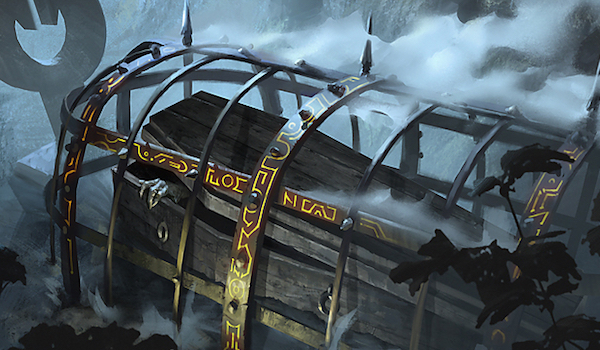
Hosers and utility cards are perhaps total opposites of one another; hosers occupy sideboards and have narrow, powerful applications, while utility cards passably play multiple roles and pepper the 75 as space allows. We'll use the same formula we did last time, but with some necessary tweaks.
Definitions and Parameters
As in Modern Top 5: Utility Spells, we won't get far in the way of constructive discussion without first defining the term at hand. Hosers are cards that single-handedly turn off or severely hinder the use of a single mechanic. Since Modern rewards deckbuilders for extreme focus, hosers generally have a high impact here—most of the format's linear decks are entirely built around a certain mechanic (Dredge, Affinity, etc.), and even its interactive decks tend to dip their hands pretty deeply into one cookie jar or another (be it graveyard synergy, one-drops, etc.). We'll again outline three parameters by which to rate the format's hosers. Power and splashability make a return today, and are likely to become staples of this kind of discussion; the third metric, flexibility, will be replaced. After all, flexibility isn't exactly what anyone looks for in hoser cards.
Power, Stickiness, Splashability
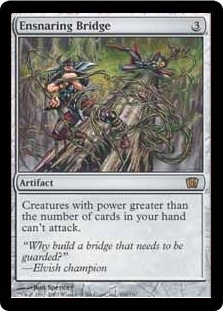 Most obvious when sizing up a card is the strength of its effect; how much does the card do for its mana cost? Many spells have different effects at different stages of the game; Engineered Explosives, for example, is great against a board of three Tarmogoyfs and miserable against a creatureless Scapeshift opponent with six lands. When it comes to hosers, a card's power level is also related to the uniqueness of its effect; Ghostly Prison and Ensnaring Bridge, for example, fight for favor in similar shells. The generally superior choice among them edges out the other(s).
Most obvious when sizing up a card is the strength of its effect; how much does the card do for its mana cost? Many spells have different effects at different stages of the game; Engineered Explosives, for example, is great against a board of three Tarmogoyfs and miserable against a creatureless Scapeshift opponent with six lands. When it comes to hosers, a card's power level is also related to the uniqueness of its effect; Ghostly Prison and Ensnaring Bridge, for example, fight for favor in similar shells. The generally superior choice among them edges out the other(s).
We'll also look at power in terms of a card's floor (the worst it can do) and ceiling (the best it can do). Since hosers are so narrow by definition, though, we'll consider their floors and ceilings in terms of the matchups they're actually sideboarded in for; otherwise, many would have a floor of zero. It would be unfair to judge hosers the same way we judge utility cards for this metric, as the latter regularly find themselves occupying flex spots in the mainboards of interactive and linear decks alike.
The reason all decks don't play such powerful cards is simple: hosers generally provide symmetrical effects. Good luck squeezing Rest in Peace into your Tarmogoyf/Lingering Souls deck! Hosers see play limited by how many decks can both wield it and ignore it. The third aspect to consider is whether the deck needs that effect to begin with—in linear decks that are fast enough, such as Affinity, turning off graveyards isn't exactly the first order of business. That deck in particular can often beat Dredge before its graveyard becomes genuinely frightening, and if the robots are worried about Conflagrate, Spell Pierce is a better side-in anyway. Taken together, these points form another crucial metric for analyzing a hoser's worth: splashability. Here we're talking not just the mana restrictions on the card, but the more general strategic ones as well.
Lastly, hosers see play based on how challenging they are to remove. While hatebear-style creatures like Aven Mindcensor boast powerful effects, countering a bird that's flashed in in response to a fetchland is as simple as casting Fatal Push. Stony Silence, for instance, asks Affinity a much tougher question: did you open a Spire of Industry? If not, the enchantment is favored to stay on the board for the rest of the game, which is then likely to end shortly. This concept forms the basis of our new second metric, stickiness.
Here are the parameters we'll use to judge our hosers:
- Power: The degree of impact the card tends to have for its cost (floor vs. ceiling).
- Stickiness: The trouble opponents have removing the card.
- Splashability: The ease with which Modern decks can accommodate the card.
We'll again rate each parameter on a 1-5 scale, with 1 being the worst and 5 being the best, and add them all up for a card's final score out of 15. To it we hop!
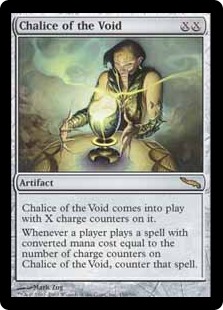 #5: Chalice of the Void
#5: Chalice of the Void
Similar cards: Eidolon of the Great Revel, Trinisphere
Power: 4
For a paltry two mana, Chalice of the Void can grind entire decks to a halt, sitting around as something of a Pandora's Box of Counterspell. But the artifact wasn't taken seriously in Modern for most of the format's lifespan. The conversion of BGx Rock to Grixis Shadow, a deck significantly more focused around the 1-CMC slot, and the subsequent metamorphosis of Gx Tron into Eldrazi Tron, a deck that can painlessly accommodate Chalice, has led to the card's meteoric rise.
Chalice is also relatively flexible. Coming down for zero on the play against Affinity can be nearly as debilitating as resolving Stony Silence. Coming down for two against UR Storm not only prevents the deck from going off, but turns off their preferred answer to hosers, Echoing Truth. And the now-constant threat of Chalice on one in Modern further contributes to Gx Tron's fall from grace. Why play a deck that loses to Chalice when you could play a similar deck that abuses it?
In relation to its contemporaries, Chalice shines even brighter. Eidolon of the Great Revel is trivial to remove, and at least gives opponents the option of resolving their spells. Trinisphere can be fought through with simple land drops and costs more than a Chalice on one.
Stickiness: 3
Chalice's ultimate balancing factor is its card type. Every Modern player packs interaction for artifacts, and between Ancient Grudge, Wear // Tear, and now By Force, there's no shortage of options available. Perhaps the single best card against Chalice of the Void is employed in multiples by the deck it directly preys upon, Grixis Shadow: Kolaghan's Command is too pricey to ever stop with a Chalice and comes with a second effect to boot. Grixis Shadow's Snap-Kommand plan gives them a line against even multiple Chalices.
That said, it does help that Chalice can be used to turn off artifact removal. Resolving it for two against Burn, for example, takes Destructive Revelry out of the picture.
Splashability: 1
The reason Chalice is so good in Modern is the same reason so few decks can play it. One-drops are everywhere in this format, and most decks would rather run even just one or two playsets of cheap interactive cards or strategic enablers than the off-theme hoser.
Overall: 8/15
 #4: Blood Moon
#4: Blood Moon
Similar cards: Choke
Power: 3
Blood Moon is a tricky hoser to evaluate. Its strength is contingent both on whether opponents open hands with the option of fetching around Moon, and on whether they choose not to fetch around it regardless. Decks like Death's Shadow don't have much of a plan against decks like RG Ponza other than to get under them, which means taking plenty of damage early on to facilitate their namesake threat. Since the most efficient way to do that is to fetch into shocklands, just the threat of Blood Moon gives Ponza a sizable edge in some games.
That threat is the next thing we'll talk about. Sure, Mooning your opponent on three shocks will probably put away the game. But players are wise to Moon now, and generally slow themselves by a turn or two to make sure that doesn't happen. Resultantly, Moon creates a weird tension—we need to run it to benefit from the effect of threatening it, but should we draw Moon instead of proactive cards after opponents slow themselves down to play around it, the speed bump is lost. Managing this tension means learning to fetch in a way that doesn't telegraph a Blood Moon when we have it (i.e. by digging out Shocks and sandbagging basics in hand), and fetching in a way that suggests it when we don't.
Moon also wins games by invalidating certain strategies. Decks revolving around certain lands, like Scapeshift or Amulet Titan, have a hard time winning through Moon even with their colors. Similarly, supplementing Moon with any kind of pressure makes it tough for big-mana strategies like Eldrazi Tron to resolve threats impactful enough to reclaim a populated battlefield.
Stickiness: 4
Enchantments are tough to remove. It helps that Blood Moon complicates casting Abrupt Decay, one of the cleanest answers around. Certain shards and wedges have few options when it comes to removing the Moon, especially Grixis (conveniently the best deck's color combination).
For some decks, killing Moon is as simple as rapidly fetching out basic Forest; after that, any Destructive Revelry or Seal of Primordium drawn will take it off the table. But that plan doesn't account for the possibility of multiple Moons, the fact that diggers like Serum Visions become harder and sometimes impossible to cast, and Moon's effect in the meantime, which otherwise prevents players from casting their spells normally. While destabilized, their opponents have plenty of time to just kill them—or to Stone Rain that Forest.
Splashability: 2
Many two- and even three-color decks featuring red can splash Blood Moon. But there aren't many of those decks out there anymore. For those that do exist, accommodating the Moon forces deckbuilders to construct their manabases a certain way that leaves them more painful (more fetches and shocks) and less flexible (fewer utility lands). Usually, this trade-off isn't worth it. But we do still see decks like Affinity packing Moons in the sideboard despite the card's non-synergy with creature lands.
Overall: 9/15
 #3: Grafdigger's Cage
#3: Grafdigger's Cage
Similar cards: Rest in Peace
Power: 3
Cage has a strange and narrow effect, but there's no arguing that it's great for the cost. If opponents draw a Lingering Souls, Snapcaster Mage, or Kitchen Finks this game, Cage has already paid for itself in terms of card economy. And it often does much more. Resolving Cage against Collected Company decks forces them to play a fair creature game with eight blanks in their deck; sticking it against reanimator strategies like Grishoalbrand or Ghost Dad similarly shunts opponents into an uncomfortable Plan B. Against Storm or Dredge, the game is just over unless opponents remove the artifact.
A big draw to hoser cards generally is how low-maintenance they are; players can resolve them and then go about their business as the hoser sits there and disrupts opponents. Usually, though, hosers cost between two and four mana, requiring players to functionally take a turn off to deploy them. Since Cage costs only one, it hardly interferes with curving or an otherwise proactive gameplan.
Stickiness: 3
Like Chalice of the Void, Cage suffers from the curse of the artifact type. But unlike Chalice, it's very hard to remove Cage at mana parity. Almost every played answer costs two or more mana (including the three-mana Qasali Pridemage and Reclamation Sage, common solutions from the Company decks Cage brutalizes). That means that at its floor in relevant matchups, Cage steals tempo from opponents. As a bonus, Modern's best destroy effect for artifacts, Ancient Grudge, can't be flashed back while Cage is in play, forcing strategies like Dredge to find their answer the old-fashioned way.
Splashability: 4
The narrowness of Cage's effect, combined with its low and generic mana cost, renders the card highly splashable. Only decks reliant on casting cards from the graveyard (featuring the aforementioned Snapcaster Mage, Lingering Souls, etc.) need skirt it. It's no wonder we've been seeing so many Cages in sideboards as of late.
Overall: 10/15
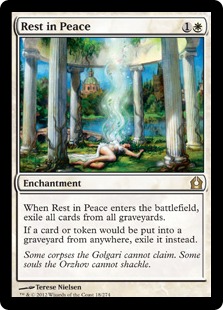 #2: Rest in Peace
#2: Rest in Peace
Similar cards: Grafdigger's Cage, Leyline of the Void
Power: 5
The only card here to earn a 5 in this category, Rest in Peace is great at virtually all stages of the game. Speed bump effects like Nihil Spellbomb and Relic of Progenitus let opponents rebuild after nuking the graveyard; similar hosers like Leyline of the Void are often too slow to have any real impact if cast later. Rest in Peace is really two cards in one, nuking the graveyard when it resolves and then preventing further abuse until dealt with. For its two-mana cost, this double-spell effect is a steal.
Stickiness: 4
Rest in Peace shares the coveted enchantment type with Blood Moon, making it tough to remove. Fortunately for opponents, their ability to find answers isn't touched by Rest in Peace; conversely, their proactive plans—be they swinging with Goyf and delve threats, growing a fleet of Amalgams, or comboing out with a huge Past in Flames—are neutered.
Splashability: 2
Many Modern decks use the graveyard, which limits Rest in Peace's appeal for some white decks. But white is also the color least likely to use the graveyard, so in one- or two-color shells, the card's a shoe-in. UW Control, Death and Taxes, and white Eldrazi decks love the card; linear strategies like Burn and Affinity have also been known to run it occasionally.
Overall: 11/15
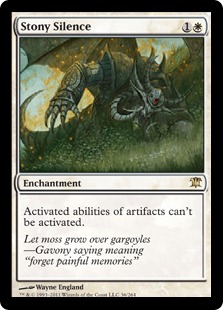 #1: Stony Silence
#1: Stony Silence
Similar cards: Damping Matrix, Suppression Field
Power: 4
Stony's as close to a "win button" as we have in Modern against artifact strategies. The other cards on this list are far from game over—they're easier to remove, for one, and their effects can be navigated around; Dredge can cast Amalgam through a Rest in Peace, for instance. And compare Stony to its kin, Damping Matrix and Suppression Field. Stony's more surgical than the former, as well as cheaper, and it blows the latter out of the water when it comes to raw power.
Stickiness: 5
Enchantment that prevents artifact sources from producing colored mana? Yes, please! And if your colors can't remove artifacts by themselves, forget about it—Ratchet Bomb and Engineered Explosives won't help you here.
Splashability: 4
Granted, Stony Silence has a color requirement. But it's not an intensive one; the card merely requires pilots to have access to white mana in any small capacity. Thanks to Affinity's recent reign of terror, we've seen Stony Silence enter sideboards all over the Modern, even in the Aether Vial-featuring Death and Taxes. The splash hate from a card this impactful is great enough to keep less proactive artifact strategies like Tezzeret and KCI Combo from rearing their ugly, metal heads.
Very few decks activate abilities of artifacts, making Stony Silence plenty splashable—and those that do all but lose to the card, making splashing it very attractive.
Overall: 13/15
Hose House?
So there you have it: the second edition of Modern Top 5! Any hosers I missed? Want to convince me why Ensnaring Bridge deserves a spot? I'll see you in the comments.





Honestly I’d put grafdiggers over RIP. It’s more splashable both on mana and who can run it, faster, and is approximately as powerful overall. (Turning off fetching creatures to play as opposed to hosing snapcaster and delve strats is a similar balance of utility depending on meta)
No mention of Kataki, War’s Wage for similar cards to Stony Silence? Heck, he could even make the list. He may get a 1 on Stickiness since he dies to a stiff breeze, but is probably a 5 on Splashability and a 3-4 on Power Level.
Kataki is generally just way worse than Stony. Many decks have little use for a 2/1 or otherwise don’t want to turn all their opponent’s Galvanic Blasts into Wear // Tears. Not to mention his effect is significantly easier to play around than the enchantment’s, which brings most artifact decks to a halt. Even non-Affinity decks like KCI can let your Kataki resolve and then go off.
Power: 1
Splashability: 3
Stickiness: 1
Total: 5
Less splashable than Stony because unlike Stony it’s not a great reason to splash on its own.
You can’t make categories and then have them bleed into each other just because you don’t like a card. Kataki is not a 1 on power level, if anything he’s way more debilitating if left unanswered. He annihilates KCI if played on turn 2, and the same goes for Lantern and Affinity if they don’t have immediate answers. If Kataki weren’t a 2/1 and were just an enchantment, it would easily be played over Stony Silence, meaning it has a higher power level. Splashability is also a 4-5. Since he’s a creature and gets tutored out by Chord/Traverse, it is much easier to play fewer copies and still find them. Yes, stickiness is a 1, but that doesn’t mean you can discount the card. I’ll gladly play it in decks like Elves or Counters Company.
Also, it’s worth noting that the hands out of Affinity that are the most likely to win through a Stony Silence just so happen to be the worst hands against Kataki. So if they’re anticipating Stony from you, Kataki can really throw a wrench in the gears.
This is an interesting point. But I think using Kataki as a way to “next-level” Affinity opponents expecting Stony will rarely work for the reason that Affinity is likely to keep its Blasts against decks that can use Kataki at all, and are also likely to bring in Whipflare and Aether Grid. That’s 6+ cards that remove him on the spot or later in the game.
His impact past the initial turns is also negligible. Affinity can just fly over Kataki with Plating every turn until its opponent dies. The deck is also likelier to have unused spot removal in the early game, where Kataki shines brightest.
Lastly, I like your argument on splashability. Agree that Kataki is slightly more splashable than Stony since he fits into creature-combo shells pretty gracefully. But again, I don’t think that’s reason to include him over the much more powerful card; see Ross Merriam’s recent Elves deck for reference, which runs Stony alongside a single Kataki and plays the 4 Chord/4CoCo package.
Unlike, say, splashability, stickiness is a very important metric for hosers. See my reply to Aaron below for more on this. Creatures, unfortunately, score miserably on stickiness, which should help explain why Kataki, Eidolon, Mindcensor, Arbiter, etc. don’t make this list (or see much play as hosers in Modern).
It’s a thoughtful analysis, and a good read. I know this was used to fight Splinter Twin decks until it came out of the meta via ban, but, what about Torpor Orb? How would it stack up against the rest of the listed hosers?
Far too narrow to make the cut here. It’s just dead against so much, and doesn’t do a lot against the format’s best decks (Affinity, DS, E-Tron) which are all hyper-focused and ripe for hosing.
Definitely agree with you on that. It’s not well positioned. But I am curious what you would rate it if you did
Sure, with a disclaimer: I don’t believe in “in a vacuum;” cards are only ever “good” or “bad” depending on context and positioning.
Torpor Orb
Power: 1
Splashability: 4
Stickiness: 3
Total: 8
Rating this card has shown me that splashability is the least important metric when it comes to whether a card sees play (though a good indicator of whether the card sees play across multiple archetypes). Chalice, for example, is nigh impossible to splash, but so powerful that it’s become a defining card in Modern—even if only one or two decks can play it. Orb, by contrast, can be played by almost everyone. But it’s not maindeckable, does very little for its cost, and is a poor use of a sideboard slot. Even though the two cards score the same, one is clearly better than the other.
This revelation makes me wonder if my rating system needs work. Perhaps the metrics should be weighted in some way.